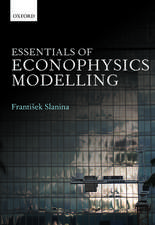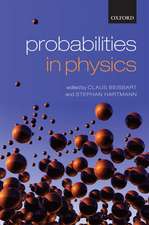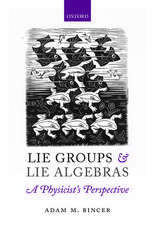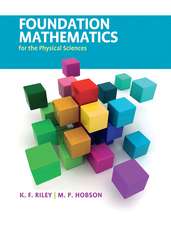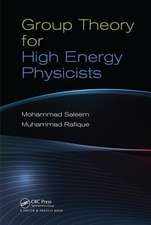Path Integral Approach to Quantum Physics: An Introduction: Theoretical and Mathematical Physics
Autor Gert Roepstorffen Limba Engleză Paperback – 20 iun 1996
Din seria Theoretical and Mathematical Physics
- 20%
 Preț: 697.22 lei
Preț: 697.22 lei - 18%
 Preț: 744.84 lei
Preț: 744.84 lei - 20%
 Preț: 699.50 lei
Preț: 699.50 lei -
 Preț: 396.82 lei
Preț: 396.82 lei - 15%
 Preț: 721.06 lei
Preț: 721.06 lei - 18%
 Preț: 1120.68 lei
Preț: 1120.68 lei -
 Preț: 398.35 lei
Preț: 398.35 lei - 15%
 Preț: 643.65 lei
Preț: 643.65 lei - 15%
 Preț: 508.60 lei
Preț: 508.60 lei - 20%
 Preț: 652.54 lei
Preț: 652.54 lei - 15%
 Preț: 646.75 lei
Preț: 646.75 lei - 15%
 Preț: 654.12 lei
Preț: 654.12 lei - 15%
 Preț: 649.87 lei
Preț: 649.87 lei -
 Preț: 396.24 lei
Preț: 396.24 lei - 15%
 Preț: 653.14 lei
Preț: 653.14 lei - 18%
 Preț: 960.78 lei
Preț: 960.78 lei - 15%
 Preț: 529.92 lei
Preț: 529.92 lei - 18%
 Preț: 1127.78 lei
Preț: 1127.78 lei - 18%
 Preț: 1548.71 lei
Preț: 1548.71 lei - 15%
 Preț: 551.53 lei
Preț: 551.53 lei - 18%
 Preț: 1002.75 lei
Preț: 1002.75 lei -
 Preț: 396.02 lei
Preț: 396.02 lei - 15%
 Preț: 648.89 lei
Preț: 648.89 lei - 18%
 Preț: 783.35 lei
Preț: 783.35 lei - 18%
 Preț: 973.38 lei
Preț: 973.38 lei - 18%
 Preț: 907.90 lei
Preț: 907.90 lei - 15%
 Preț: 655.78 lei
Preț: 655.78 lei - 18%
 Preț: 1118.93 lei
Preț: 1118.93 lei -
 Preț: 390.25 lei
Preț: 390.25 lei - 15%
 Preț: 663.79 lei
Preț: 663.79 lei - 15%
 Preț: 653.79 lei
Preț: 653.79 lei - 15%
 Preț: 645.28 lei
Preț: 645.28 lei - 15%
 Preț: 604.23 lei
Preț: 604.23 lei - 15%
 Preț: 639.25 lei
Preț: 639.25 lei - 15%
 Preț: 590.81 lei
Preț: 590.81 lei -
 Preț: 395.25 lei
Preț: 395.25 lei - 15%
 Preț: 589.33 lei
Preț: 589.33 lei - 19%
 Preț: 543.19 lei
Preț: 543.19 lei - 15%
 Preț: 594.24 lei
Preț: 594.24 lei - 18%
 Preț: 911.17 lei
Preț: 911.17 lei - 18%
 Preț: 957.75 lei
Preț: 957.75 lei -
 Preț: 409.13 lei
Preț: 409.13 lei - 15%
 Preț: 532.23 lei
Preț: 532.23 lei
Preț: 532.70 lei
Preț vechi: 626.70 lei
-15% Nou
Puncte Express: 799
Preț estimativ în valută:
101.94€ • 109.00$ • 84.99£
101.94€ • 109.00$ • 84.99£
Carte tipărită la comandă
Livrare economică 18 aprilie-02 mai
Preluare comenzi: 021 569.72.76
Specificații
ISBN-13: 9783540611066
ISBN-10: 3540611061
Pagini: 404
Ilustrații: XIII, 387 p. 2 illus., 1 illus. in color.
Dimensiuni: 155 x 235 x 21 mm
Greutate: 0.56 kg
Ediția:Softcover reprint of the original 1st ed. 1994
Editura: Springer Berlin, Heidelberg
Colecția Springer
Seria Theoretical and Mathematical Physics
Locul publicării:Berlin, Heidelberg, Germany
ISBN-10: 3540611061
Pagini: 404
Ilustrații: XIII, 387 p. 2 illus., 1 illus. in color.
Dimensiuni: 155 x 235 x 21 mm
Greutate: 0.56 kg
Ediția:Softcover reprint of the original 1st ed. 1994
Editura: Springer Berlin, Heidelberg
Colecția Springer
Seria Theoretical and Mathematical Physics
Locul publicării:Berlin, Heidelberg, Germany
Public țintă
Lower undergraduateCuprins
1. Brownian Motion.- 1.1 The One-Dimensional Random Walk.- 1.2 Multidimensional Random Walk.- 1.3 Generating Functions.- 1.4 The Continuum Limit.- 1.5 Imaginary Time.- 1.6 The Wiener Process.- 1.7 Expectation Values.- 1.8 The Ornstein-Uhlenbeck Process.- 2. The Feynman-Kac Formula.- 2.1 The Conditional Wiener Measure.- 2.2 The Integral Equation Method.- 2.3 The Lie-Trotter Product Method.- 2.4 The Brownian Tube.- 2.5 The Golden-Thompson-Symanzik Bound.- 2.6 Hamiltonians and Their Associated Processes.- 2.7 The Thermodynamical Formalism.- 2.8 A Case Study: the Harmonic Spin Chain.- 2.9 The Reflection Principle.- 2.10 Feynman Versus Wiener Integrals.- 3. The Brownian Bridge.- 3.1 The Canonical Scaling of Brownian Paths.- 3.2 Bounds on the Transition Amplitude.- 3.3 Variational Principles.- 3.4 Bound States.- 3.5 Monte Carlo Calculation of Path Integrals.- 4. Fourier Decomposition.- 4.1 Random Fourier Coefficients.- 4.2 The Wigner-Kirkwood Expansion of the Effective Potential.- 4.3 Coupled Systems.- 4.4 The Driven Harmonic Oscillator.- 4.5 Oscillating Electric Fields.- 5. The Linear-Coupling Theory of Bosons.- 5.1 Path Integrals for Bosons.- 5.2 A Random Potential for the Electron.- 5.3 The Polaron Problem.- 5.4 The Field Theory of the Polaron Model.- 6. Magnetic Fields.- 6.1 Heuristic Considerations.- 6.2 Itô Integrals.- 6.3 The Constant Magnetic Field.- 6.4 Diamagnetism of Electrons in a Solid.- 6.5 Magnetic Flux Lines.- 7. Euclidean Field Theory.- 7.1 What Is a Euclidean Field?.- 7.2 The Euclidean Two-Point Function.- 7.3 The Euclidean Free Field.- 7.4 Gaussian Functional Integrals.- 7.5 Basic Postulates.- 8. Field Theory on a Lattice.- 8.1 The Lattice Version of the Scalar Field.- 8.2 The Euclidean Propagator on the Lattice.- 8.3 The Variational Principle.- 8.4 TheEffective Action.- 8.5 The Effective Potential.- 8.6 The Ginzburg-Landau Equations.- 8.7 The Mean-Field Approximation.- 8.8 The Gaussian Approximation.- 9. The Quantization of Gauge Theories.- 9.1 The Euclidean Version of Maxwell Theory.- 9.2 Non-Abelian Gauge Theories: Preliminaries.- 9.3 The Faddeev-Popov Quantization.- 9.4 Gauge Theories on a Lattice.- 9.5 Wegner-Wilson Loops.- 9.6 The SU(n) Higgs Model.- 10. Fermions.- 10.1 The Dirac Field in Minkowski Space.- 10.2 The Euclidean Dirac Field.- 10.3 Grassmann Algebras.- 10.4 Formal Derivatives.- 10.5 Formal Integration.- 10.6 Functional Integrals of QED.- 10.7 The SU(n) Gauge Theory with Fermions.- Appendices.- A List of Symbols and Glossary.- B Frequently Used Gaussian Processes.- C Jensen’s Inequality.- D A Table of Path Integrals.- References.



